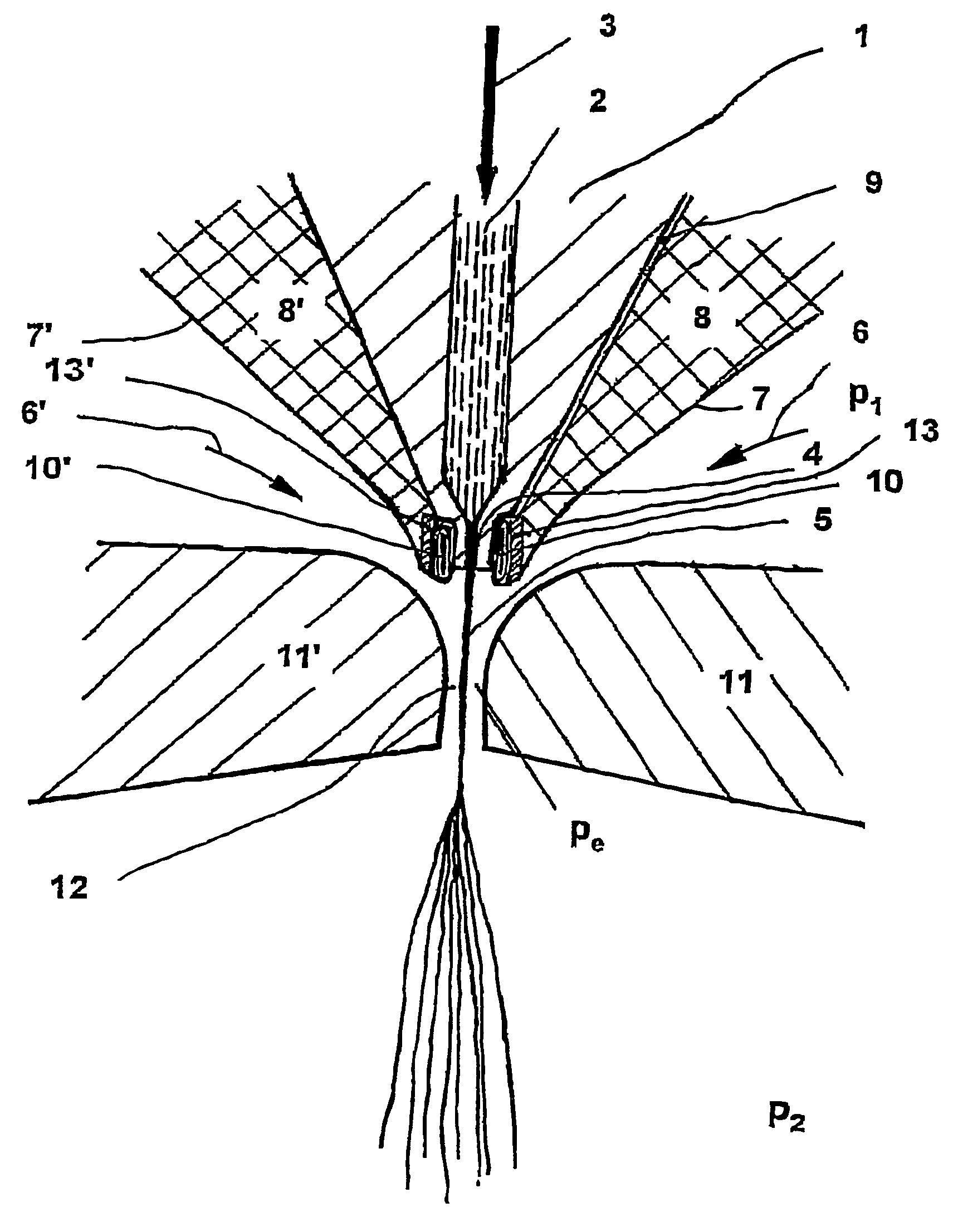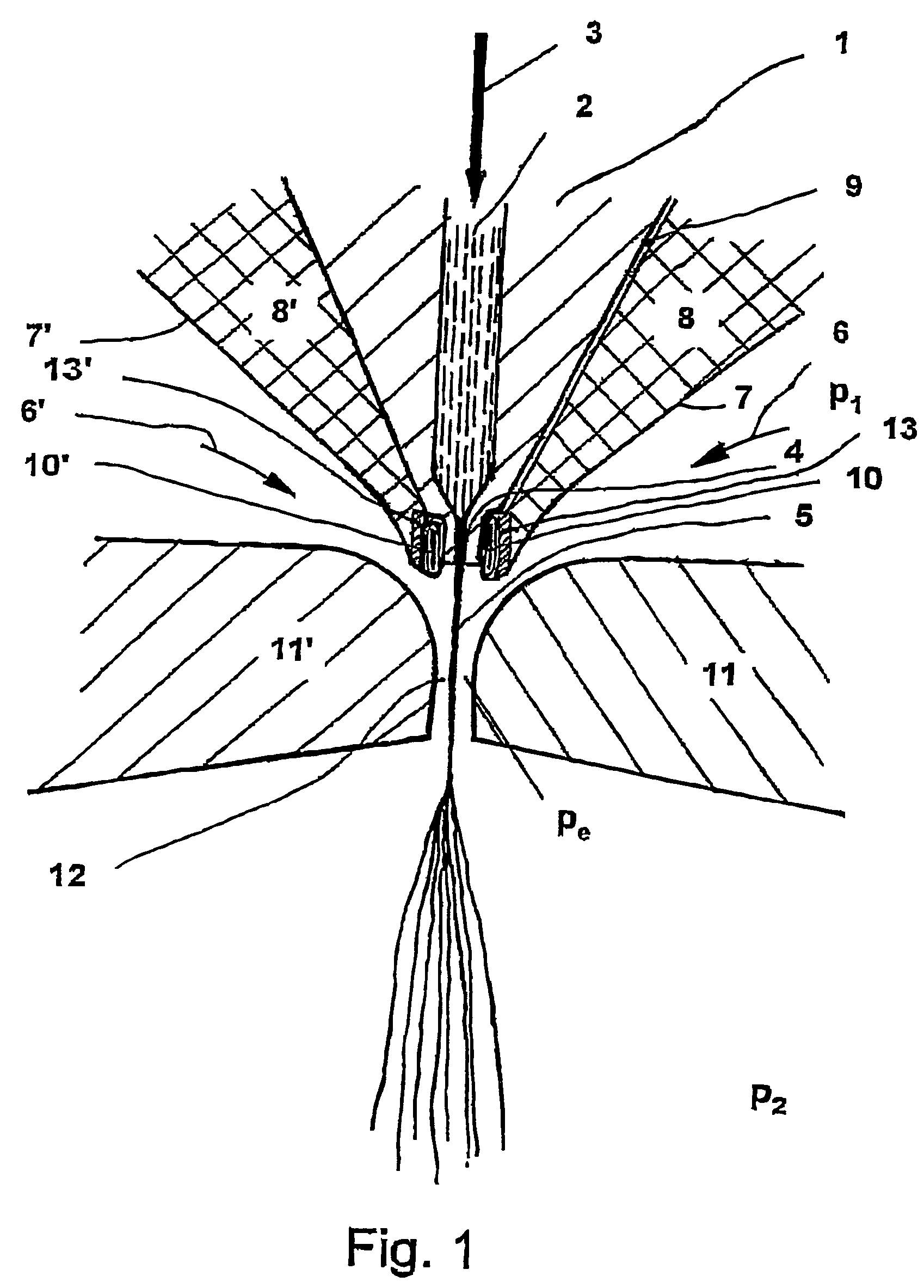Method and device for producing substantially endless fine threads
a technology of substantially endless threads and fine threads, applied in the direction of spinnerette packs, ceramic shaping apparatuses, domestic applications, etc., can solve the problems of limited throughput, thermal damage of polymers, beads and protruding fibres, etc., and achieve the effect of reducing strength, less susceptible to faults, and significant energy
- Summary
- Abstract
- Description
- Claims
- Application Information
AI Technical Summary
Benefits of technology
Problems solved by technology
Method used
Image
Examples
example 2
[0046]In a device such as that in Example 1, a solution of 8% cellulose in 78% NMMO and residual water of 14% was spun from spinning borings with a diameter of 0.6 mm. The temperature of the solution at the extruder outlet was 115° C. and, in the distribution chamber of the solution to in total twenty spinning borings, was 114° C. The heating power of the heating device on both sides of the nozzle tip was 450 W. The throughput per spinning boring was 3.6 g / min.
[0047]The following thread diameters of the substantially endless lyocell threads were produced dependent upon the pressure of the unheated air.
[0048]
TABLE 2P1d50dmindmaxCVuLeuF50No.mbarμmμmμm%m / sm / s51608.52.821.1591566772008.03.714.7391737892509.72.716.33919252113009.25.118.44320961
[0049]Despite increasing air pressure p1, measured before the Laval nozzle, the threads become thicker again from p1=200 mbar, which can be attributed to a quicker cooling due to the higher air flow.
[0050]The speed of the air in the narrowest cross...
example 3
[0054]In a spinning device similar to that shown in FIG. 1, a polypropylene melt with a temperature of 355° C. was spun from a slot of 0.9 mm width and 20 mm length as a film, from a spinning nozzle terminating at the bottom as a web. Air served as drawing gas for the film. With a throughput of 11.5 g / min and a pressure of the air of room temperature of 20° C. and 250 mbar, threads with an average diameter of 5.2 μm were produced with a scatter of s=1.9 μm, corresponding to a variation coefficient of CV=37%. The thick knotted places in the non-woven fabric were thereby not included in the measurement. The produced non-woven fabric is illustrated in FIG. 3, which shows the photo of a microscopic picture of the PP split threads according to Example 2. In FIG. 4, polypropylene split threads are shown for comparison, which threads were spun under otherwise identical conditions from a round spinning boring with a diameter of 1 mm and with a throughput per boring of 3.6 g / min. The threads...
PUM
| Property | Measurement | Unit |
|---|---|---|
| diameters | aaaaa | aaaaa |
| diameters | aaaaa | aaaaa |
| diameters | aaaaa | aaaaa |
Abstract
Description
Claims
Application Information
 Login to View More
Login to View More - R&D
- Intellectual Property
- Life Sciences
- Materials
- Tech Scout
- Unparalleled Data Quality
- Higher Quality Content
- 60% Fewer Hallucinations
Browse by: Latest US Patents, China's latest patents, Technical Efficacy Thesaurus, Application Domain, Technology Topic, Popular Technical Reports.
© 2025 PatSnap. All rights reserved.Legal|Privacy policy|Modern Slavery Act Transparency Statement|Sitemap|About US| Contact US: help@patsnap.com



